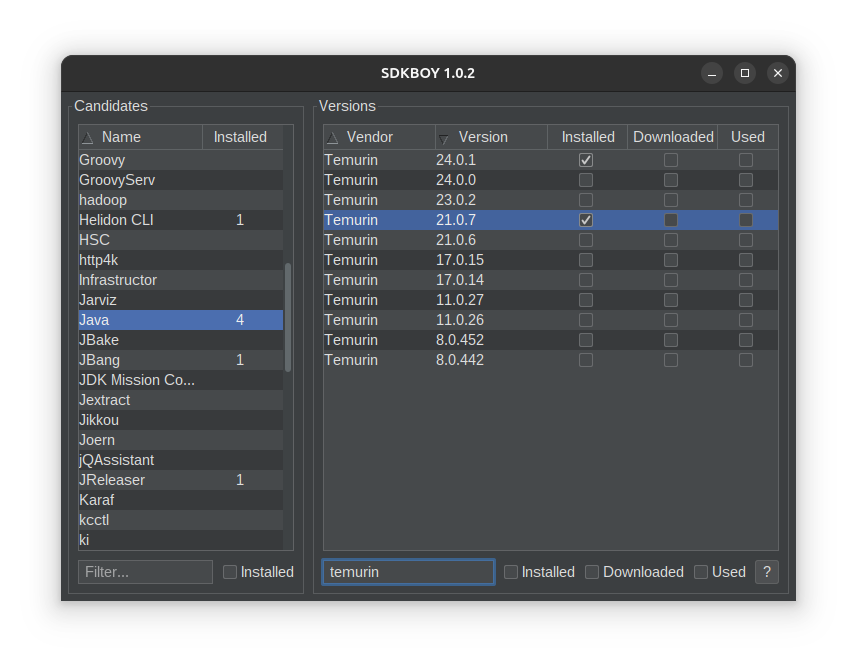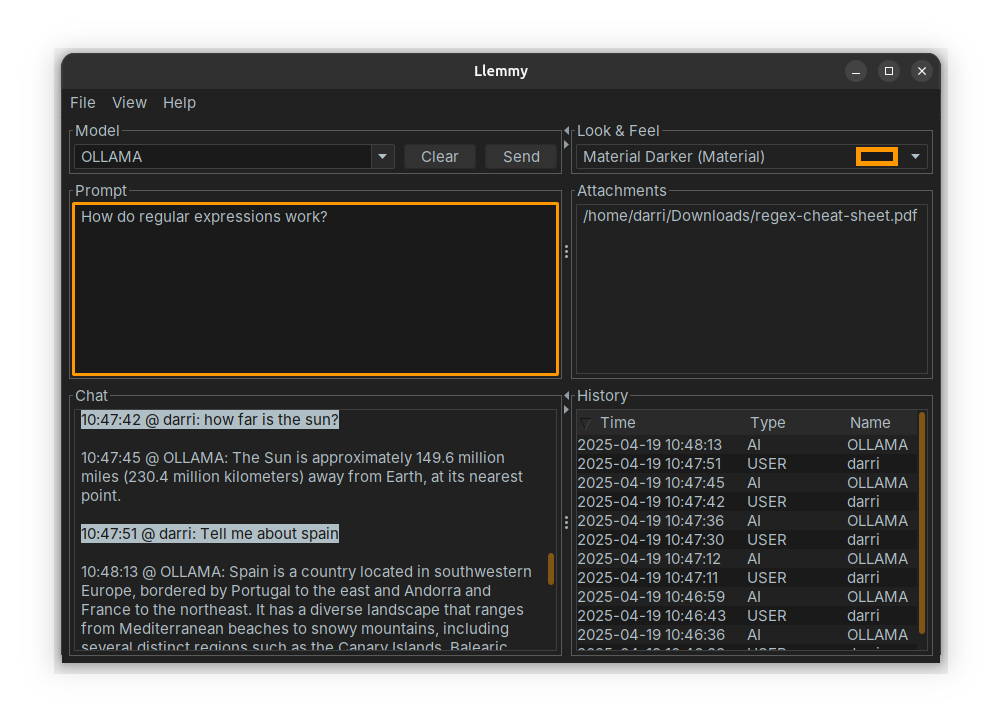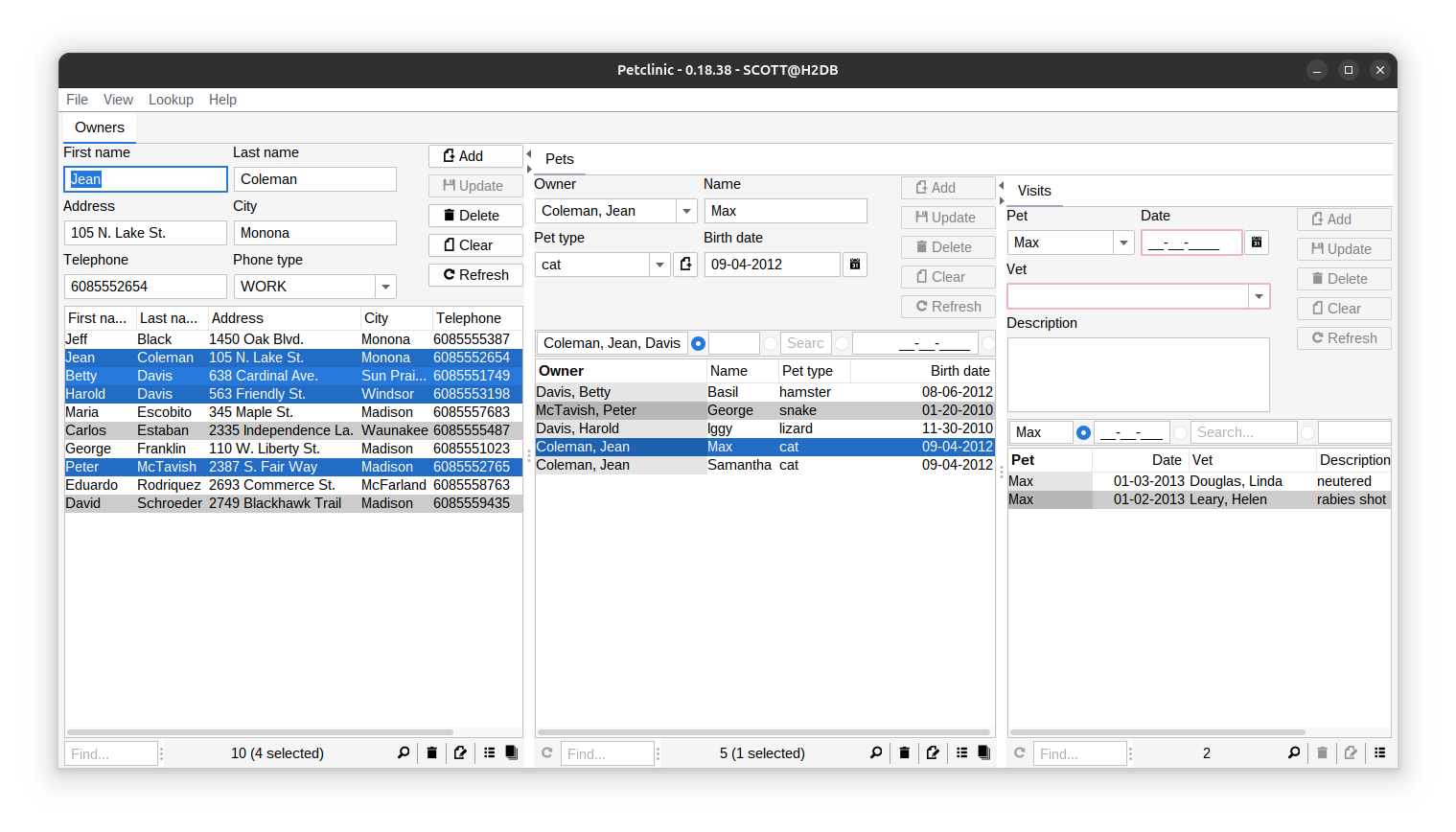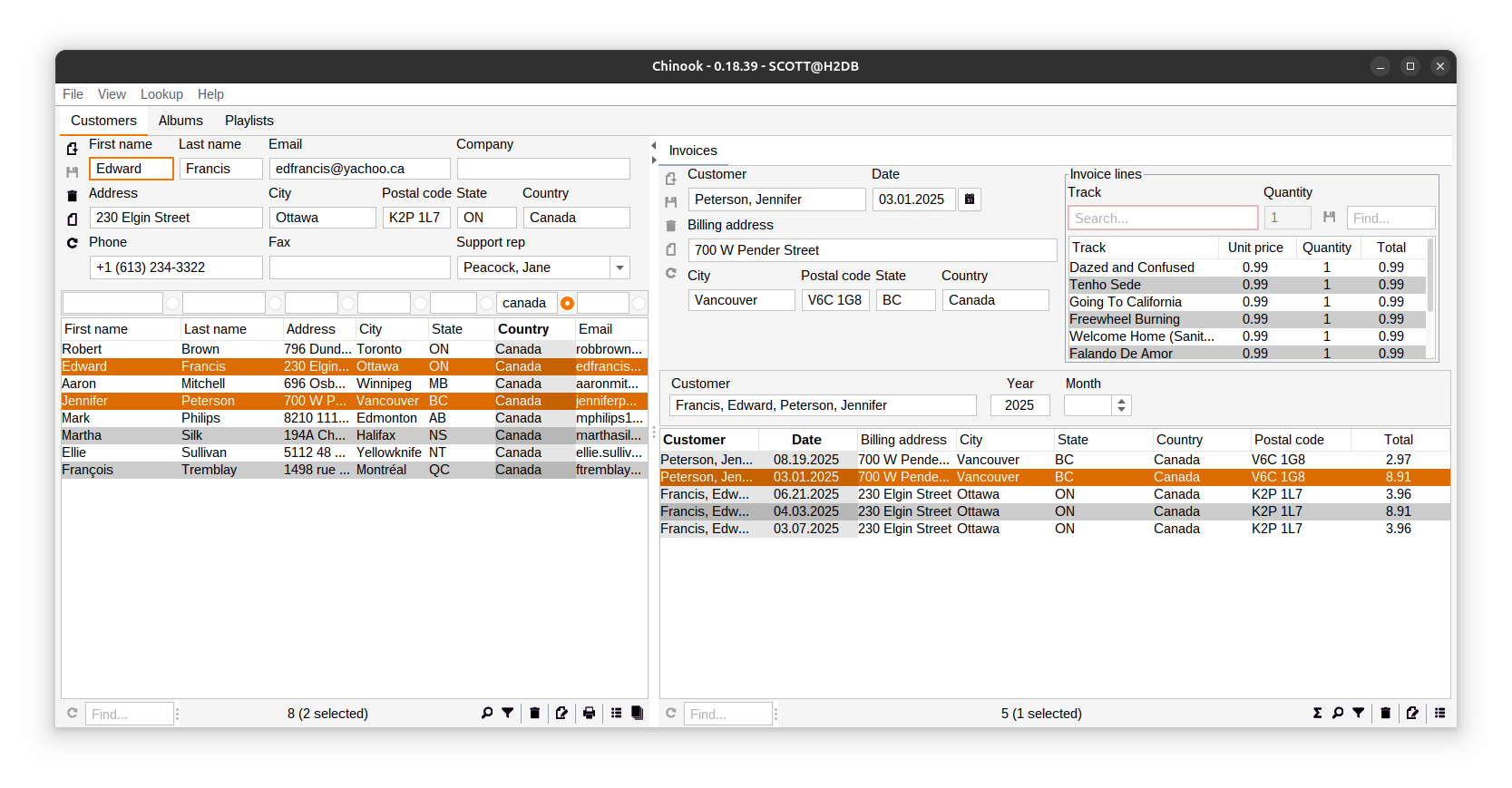
Codion Desktop
Application Framework
Observable Models
public final class CandidateModel {
private final FilterTableModel<CandidateRow, CandidateColumn> tableModel;
private final State installedOnly;
public CandidateModel() {
tableModel = FilterTableModel.builder()
.columns(new CandidateTableColumns())
.items(new CandidateItems())
.included(new CandidateIncluded())
.build()
installedOnly = State.builder()
.listener(tableModel.items()::filter)
.build()
}
public FilterTableModel<CandidateRow, CandidateColumn> tableModel() {
return tableModel;
}
public State installedOnly() {
return installedOnly;
}
}Reactive Components
public final class CandidatePanel extends JPanel {
private final FilterTable<CandidateRow, CandidateColumn> table;
private final JCheckBox installedOnly;
public CandidatePanel(CandidateModel candidateModel, ObservableState installing) {
table = FilterTable.builder()
.model(candidateModel.tableModel())
.sortable(false)
.enabled(installing.not())
.cellRenderer(CandidateColumn.INSTALLED,
FilterTableCellRenderer.builder()
.columnClass(Integer.class)
.horizontalAlignment(CENTER)
.build())
.build();
installedOnly = checkBox()
.link(candidateModel.installedOnly())
.text("Installed")
.mnemonic('T')
.enabled(installing.not())
.build();
}
}Type-Safe Domain Modeling
// Domain API
interface Country {
EntityType TYPE = DOMAIN.entityType("world.country");
Column<String> CODE = TYPE.stringColumn("code");
Column<String> NAME = TYPE.stringColumn("name");
Column<Integer> POPULATION = TYPE.integerColumn("population");
Column<Integer> CAPITAL_ID = TYPE.integerColumn("capital_id");
ForeignKey CAPITAL_FK = TYPE.foreignKey("capital_fk", CAPITAL_ID, City.ID);
}
// Domain Implementation
EntityDefinition country() {
return Country.TYPE.as(
Country.CODE.as()
.primaryKey()
.caption("Code")
.maximumLength(3),
Country.NAME.as()
.column()
.caption("Name")
.nullable(false)
.maximumLength(52),
Country.POPULATION.as()
.column()
.caption("Population")
.nullable(false),
Country.CAPITAL_ID.as()
.column()
.nullable(false),
Country.CAPITAL_FK.as()
.foreignKey()
.caption("Capital"))
.caption("Country")
.build();
}Declarative UI Building
// UI Component Creation & Layout
@Override
protected void initializeUI() {
// Create typed components
createTextField(Country.CODE)
.columns(3)
.upperCase(true);
createTextField(Country.NAME)
.columns(20);
createIntegerField(Country.POPULATION)
.columns(10)
.minimum(0)
.nullable(false);
createComboBoxPanel(Country.CAPITAL_FK, this::createCapitalEditPanel)
.includeAddButton(true)
.includeEditButton(true)
.preferredComboBoxWidth(180);
setLayout(flexibleGridLayout(3, 1));
// Layout with input panels
add(borderLayoutPanel()
.west(createInputPanel(Country.CODE))
.center(createInputPanel(Country.NAME)));
addInputPanel(Country.POPULATION);
addInputPanel(Country.CAPITAL_FK);
}
// Complete Application Bootstrap
EntityApplication.builder(WorldAppModel.class, WorldAppPanel.class)
.domain(World.DOMAIN)
.version(WorldAppModel.VERSION)
.icon(WorldAppPanel.ICON)
.startupDialog(false)
.defaultLookAndFeel(MonokaiPro.class)
.defaultUser(User.parse("scott:tiger"))
.start();Key Features
🖥️ Desktop First
When web deployment isn't required, desktop applications can provide responsive interfaces without browser constraints.
Native Desktop Advantages
• Keyboard navigation throughout with plenty of shortcuts
• System integration with file dialogs, clipboard, and desktop features
• True multitasking without browser tab limitations
• Lower memory usage compared to web applications
• Offline capability with local data and no network dependencies
Desktop UI Components
Tables, forms, and controls that handle large datasets efficiently. Context menus, drag-and-drop, focus management, and accessibility features that work across platforms.
Modern Themes
Include ~50 FlatLAF Look and Feels. Users can dynamically switch between Material themes (Darker, Oceanic, Night Owl), developer favorites (Dracula, One Dark, Gruvbox), or nature-inspired themes (Aurora Borealis, Sakura) without restarting (View → Select Look & Feel).
// Include the 6 core Flat Look and Feels
<dependency>
<groupId>is.codion</groupId>
<artifactId>codion-plugin-flatlaf</artifactId>
</dependency>
// Include ~50 IntelliJ theme based Flat Look and Feels
<dependency>
<groupId>is.codion</groupId>
<artifactId>codion-plugin-flatlaf-intellij-themes</artifactId>
</dependency>🔒 Type Safe
Every aspect of Codion is compile-time checked. No string-based column references, no runtime surprises. Foreign keys are first-class citizens with automatic loading.
// Compile-time safety everywhere
Entity country = connection.selectSingle(Country.CODE.equalTo("USA"));
String capitalName = country.get(Country.CAPITAL_FK).get(City.NAME);
// Query results are type-checked at compile time
List<String> artistNames = connection.select(Artist.NAME, Artist.ID.in(1, 2));
// Generic column definitions with type safety
Column<List<String>> TAGS = TYPE.column("tags", new TypeReference<>() {});
Column<Location> COORDINATES = TYPE.column("location", Location.class);
// Conditions enforce correct attribute types
Condition lowRated = Track.RATING.lessThanOrEqualTo(4);
Condition expensive = Track.UNITPRICE.greaterThan(BigDecimal.ONE);🔄 Observable by Design
Everything in Codion is observable. UI components automatically update when data changes. No manual synchronization, no event bus complexity. Just declare relationships and watch them work.
// Traditional approach - manual synchronization
textField.getDocument().addDocumentListener(new DocumentListener() {
public void changedUpdate(DocumentEvent e) { updateFilter(); }
public void removeUpdate(DocumentEvent e) { updateFilter(); }
public void insertUpdate(DocumentEvent e) { updateFilter(); }
});
button.setEnabled(false); // Remember to update this everywhere!
// Codion approach - synchronous observable binding
Value<String> filter = Value.nullable();
State canSubmit = State.and(hasData, isValid);
JTextField filterField = Components.stringField()
.link(filter)
.hint("Filter...")
.build();
JButton submitButton = Components.button()
.action(submitAction)
.enabled(canSubmit) // Updates automatically and synchronously!
.build();📉 Reduces Complexity
Adding ONE detail table causes 61-109% code explosions in other frameworks. That's just basic CRUD - for business-grade features (sortable columns, keyboard navigation, export, validation indicators), other frameworks need 10-15x more code.
// Basic master-detail
React + Node.js: 515 lines
Spring Boot: 355 lines
Codion: 143 lines (with enterprise features included)
// For feature parity with Codion's defaults:
React + Node.js: ~1,915 lines (+1,400 for table features)
Spring Boot: ~1,355 lines (+1,000 for UI features)
Codion: 143 lines (no additional code needed)⚔️ Battle tested
Codion has powered 50+ production applications over 20 years across scientific and government institutions, including critical infrastructure systems.
🪶 Lightweight
Codion is built on Java Standard Edition - Swing, JDBC, and RMI. No third-party application servers or complex deployment scenarios.
Resource Efficiency
Codion applications typically use fewer resources than Electron-based counterparts:
// Typical resource usage comparison:
Electron app: 400MB+ RAM, 150MB+ disk
Codion app: 40-80MB RAM, 15MB disk
// CPU efficiency:
Electron: Constant background activity
Codion: Near-zero when idle🤖 AI/LLM Ready
Codion's parameterized builder APIs enable code generation. Every method takes explicit parameters, making it suitable for AI-assisted development.
// LLM-friendly APIs
Components.stringField()
.link(nameValue)
.columns(20)
.upperCase(true)
.maximumLength(20)
.action(insertAction)
.horizontalAlignment(CENTER)
.selectAllOnFocusGained(true)
.transferFocusOnEnter(true);🏗️ Domain-Driven Design
Your business domain becomes executable, type-safe code. Define entities once with rich metadata, and Codion generates all CRUD operations, validations, and UI components automatically.
// Define your domain - this is all you need!
interface Customer {
EntityType TYPE = DOMAIN.entityType("store.customer");
Column<String> NAME = TYPE.stringColumn("name");
Column<String> EMAIL = TYPE.stringColumn("email");
Column<BigDecimal> CREDIT_LIMIT = TYPE.bigDecimalColumn("credit_limit");
}
// This definition provides:
// ✓ Type-safe CRUD operations
// ✓ Form validation and UI components
// ✓ Search and filter capabilities
// ✓ Foreign key navigation
// Use it everywhere with compile-time safety:
Entity.Key customerKey = connection.insert(
entities.entity(Customer.TYPE)
.with(Customer.NAME, "John Doe")
.with(Customer.EMAIL, "john@example.com")
.with(Customer.CREDIT_LIMIT, new BigDecimal(10_000))
.build());🚀 Rapid Development With Joy
Minimal boilerplate and configuration. From domain model to working CRUD application in hours. Clean APIs with IDE support and compile-time safety.
// Domain definitions for a couple of tables ~100 lines
// Initial application and UI setup ~150 lines
// Run application and start testing



